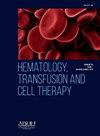A dream or reality: Consideration of ‘bloodless’ hematopoietic stem cell transplants for Jehovah’s witness patients
IF 1.6
Q3 HEMATOLOGY
引用次数: 0
Abstract
Background
Hematopoietic stem cell transplantation (HSCT) is an important part of treatment for many hematologic conditions. The high-dose chemotherapy used in HSCTs puts patients at risk of significant cytopenias which often necessitate blood product transfusions. Certain populations, including Jehovah’s Witnesses, are unable to receive blood product transfusions during their transplant and thus, in the past, they have been seen as unsuitable candidates for transplantations. However, there has been growing evidence of the safety and efficacy of so-called “bloodless” HSCT protocols.
Methods
The most recent and relevant literature on “bloodless” transplants were identified through Embase, MEDLINE, and PubMed, and analyzed to construct a “bloodless” HSCT protocol at a Canadian centre. Since 2021, the regimen was utilized for four autologous transplantations in three different Jehovah’s Witness patients.
Results
None of the patients had a significant bleeding event nor a hemoglobin nadir below 8.0 g/dL. Minor bleeding events, predominantly mucositis, resolved with site-specific management. No patient had significant thrombocytopenia, and all the cell lines of patients had normalized without transfusions by the time of discharge. All patients were hospitalized for <30 days, similar to the experience of the centre with “regular” autologous transplants.
Conclusion
Careful planning and tailored regimens support the achievability of “bloodless” HSCTs in patients, such as Jehovah’s Witnesses, allowing practitioners to provide care to a previously excluded group and minimize the use of blood products in all HSCT patients.
造血干细胞移植(HSCT)是许多血液病治疗的重要组成部分。在造血干细胞移植中使用的高剂量化疗使患者面临严重的细胞减少的风险,这通常需要输血。然而,越来越多的证据表明所谓的“无血”造血干细胞移植方案的安全性和有效性。方法通过Embase、MEDLINE和PubMed检索“无血”移植的最新相关文献,分析并构建加拿大某中心的“无血”造血干细胞移植方案。结果所有患者均无明显出血,血红蛋白最低值均低于8.0 g/dL。轻微出血事件,主要是粘膜炎,通过部位特异性治疗得以解决。无明显血小板减少,出院时无输血患者细胞系均正常。所有患者住院30天,与该中心进行“常规”自体移植的经验类似。
本文章由计算机程序翻译,如有差异,请以英文原文为准。
求助全文
约1分钟内获得全文
求助全文
来源期刊

Hematology, Transfusion and Cell Therapy
Multiple-
CiteScore
2.40
自引率
4.80%
发文量
1419
审稿时长
30 weeks
 求助内容:
求助内容: 应助结果提醒方式:
应助结果提醒方式:


